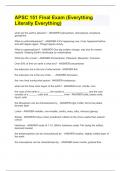APSC 151 Final Exam (Everything Literally Everything)
what are the earth's spheres? - ANSWER-hydrosphere, atmosphere, biosphere, geosphere
What is uniformitarianism? - ANSWER-If it's happening now, it has happened before and will happen again. Things happen slowly
What is catastrophism? - ANSWER-One big sudden change, only true for meteor impacts. Shaping Earth's landscape by catastrophes.
What are the 4 eras? - ANSWER-Precambrian, Paleozoic, Mesozoic, Cenozoic
Over 80% of time on earth is what era? - ANSWER-precambrian
the paleozoic era is the era of what animal - ANSWER-fish
the mesozoic era is the era of the ... - ANSWER-dinosaurs
the t-rex lived suring what period - ANSWER-cretaceous
what are the three main layers of the earth? - ANSWER-crust, mantle, core
the crust of the earth is _______ the mantle is ________ _________ and the core consists of a ______ outer and ___________ inner - ANSWER-solid, plastic solid, liquid, solid
the lithosphere can be characterized by: - ANSWER-rigid, brittle, forms the plates, thinnest layer
Lustre - ANSWER-metallic, non-metallic, earthy, waxy, silky, vitreous (glassy)
Streak - ANSWER-Colour when powdered/ rubbed on tile (more useful than exterior colour)
Hardness - ANSWER-scale of 1-10, (Moh's hardness scale) Talc being the softest, diamond hardest
the asthenosphere can be characterized by: - ANSWER-weaker, slightly melted layer of
the earth
the mesosphere can be characterized by: - ANSWER-lower mantle, gradual flow aphanitic - ANSWER-rapidly cooled, barely any crystals (fine grained surface), rhyolite, andesite, basalt
phaneritic - ANSWER-slow cooling, visible crystals (rough grained), granite, diorite, gabbro
pegmatitic - ANSWER-very slow cooled, almost wholly crystals
the core can be characterized by: - ANSWER-composed of iron and nickel
continental drift was proposed by who and in what year? - ANSWER-Alfred Wagner, 1915
What are the past supercontinents? - ANSWER-pangea, gondwanaland, rodinia, columbia
What is a geomagnetic reversal? - ANSWER-The earth periodically reversing polarity, shown in rocks from those eras.
movement driven by convection is about ____ cm/year - ANSWER-2-5
What are the different plate boundary types? - ANSWER-Divergent, convergent, and transforming
divergent plate boundaries - ANSWER-plates move apart creating mid-ocean ridges or rift valleys
convergent plate boundaries - ANSWER-plates move towards each other and collide creating subduction zones
subduction zone - ANSWER-one plate being sucked under the other
transforming boundaries - ANSWER-plates pass each other and nothing new is formed
An example of a transform fault is: - ANSWER-New Zealand San Andreas fault
What is the definition of a mineral - ANSWER-naturally occurring, inorganic, solid, ordered atomic structure, definite chemical composition
polymorph - ANSWER-One mineral that can take multiple forms
an example of a polymorph is - ANSWER-Carbon (is graphite and diamond) Physical properties include - ANSWER-Crystal habit, Lustre, Colour, Streak, Hardness, Cleavage, Specific Gravity, Specific weight, Magnetism, Reaction to Acid, Double refraction, Malleability, Elasticity, Polarized Light, Striations
Crystal habit - ANSWER-the general shape of a crystal (cubic, sheet, acicular/fibrous ie asbestos)
Cleavage - ANSWER-tendency to break along planes, includes number of planes and angles between planes
fracture - ANSWER-Absence of cleavage when a mineral is broken
A mineral with 1 direction of cleavage: - ANSWER-muscovite
minerals with 2 cleavage planes at 90 degrees - ANSWER-orthoclase, feldspar
mineral with 2 cleavage planes not at 90 degrees - ANSWER-amphibole
mineral with 3 cleavage planes not at 90 degrees - ANSWER-calcite
mineral with 4 cleavage planes - ANSWER-fluorite
mineral with conchoidal fracture (no cleavage planes) - ANSWER-quartz
specific gravity - ANSWER-density relative to water
specific weight - ANSWER-weight of a mineral relative to a volume of water of equal weight
example of a mineral with magnetism - ANSWER-magnetite
example of a mineral that reacts with acid and has double refraction - ANSWER-calcite
what are the different mineral classes? - ANSWER-silicates, oxides, sulphides, native elements, sulphates, halides, phosphates, carbonates, and hydroxides
silicates - ANSWER-formed mainly from SiO2, different complexities of chain affect cleavage planes, olivine, pyroxene, amphiboles, biotite, muscovite, feldpsars, quartz
oxides - ANSWER-metals combined with oxygen, hematite, magnetite, rust (Al2O3)
sulphides - ANSWER-primary metal and sulfur, galena, sphalerite
native elements - ANSWER-gold, copper
sulphates - ANSWER-gypsum, anhydrite halides - ANSWER-halite, fluorite
phosphates - ANSWER-apatite, turquoise
carbonates - ANSWER-dolomite, calcite
hydroxides - ANSWER-limonite, bauxite
Bauxite contains what metal - ANSWER-aluminum
extrusive rocks... - ANSWER-solidify at the surface, generally cool faster, xan be explosive or flowing, lava flows
three words to describe lava flows are: - ANSWER-fluid, viscous, sluggish
examples of extrusive rocks includes: - ANSWER-pyroclastic flow, volcanic ash, volcanoes, and lava
Intrusive rocks... - ANSWER-solidify at depth, called plutonic rocks (plutons), visible due
to weathering/erosion
examples of intrusive rock bodies include: - ANSWER-batholiths (huge), lacoliths (unformed volcanoes, small batholith), sills (horizontal intrusions), dyes (vertical intrusion)
magma - ANSWER-Molten rock beneath the earth's surface, consists of melt, solids, and volatiles
volatiles affect what characteristic of magma? - ANSWER-its viscosity, more volatiles makes the magma less viscous
Crystallization - ANSWER-magma cooling into crystalline structures
magmatic differentiation - ANSWER-the formation of one or more secondary magmas from a single parent magma
What are the types of magma? - ANSWER-ultramafic, mafic, intermediate (andesitic), felsic
Examples of ultramafic magma - ANSWER-peridotite, komatite
mafic magma - ANSWER-dark, dense, oceanic floor
examples of mafic magma - ANSWER-basalt, gabbro




